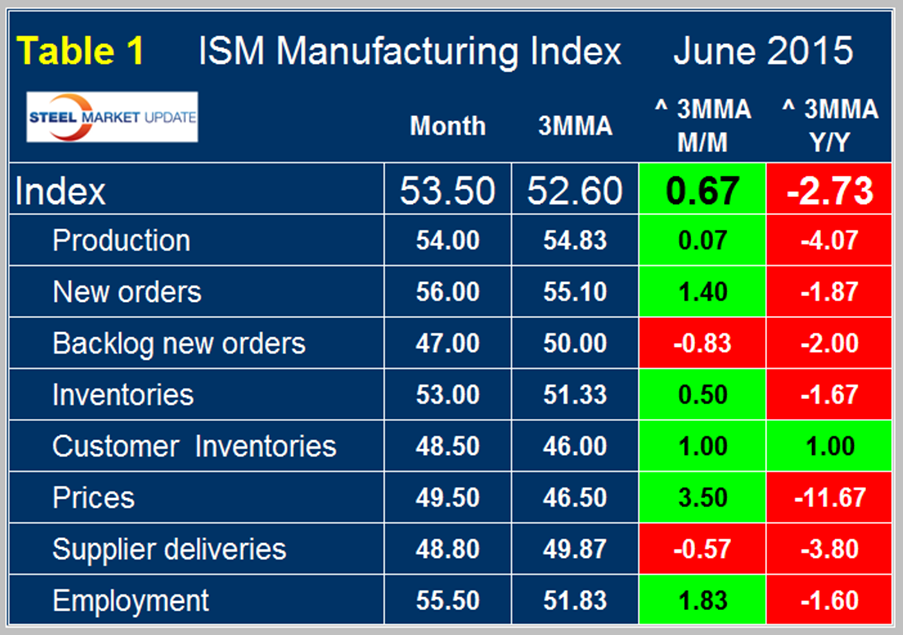Economy

The ISM Manufacturing Index Again Shows Positive Growth in June
Written by Peter Wright
July 2, 2015
The Institute of Supply Management released their June report on July 1st. An explanation of the ISM index is given at the end of this piece. After seven straight months of decline the index gained 1.3 points in May and a further 0.7 points in June to end at 53.5 with a three month moving average of 52.60.
The June gain was sufficient to reverse the decline in the 3MMA which had been ongoing for seven months. Any number >50 indicates expansion. The three month moving average is now above the 302 month average since March 1990 which stands at 52.21. There has only been one month in over five years that the index has not exceeded the positive growth threshold of 50 (Figure 1).
Table 1 shows the break down for June by sub component with the monthly result, the 3MMA, the growth of the 3MMA m/m and y/y for each.
The table shows that the 3MMA y/y growth was negative 2.73 which was the fourth consecutive month of negative growth y/y after eleven straight months of positive year over year growth. The good news is that after seven straight months in which the 3MMA declined, June reversed that trend. Month over month all sub-components except order backlog and supplier deliveries improved. Prices, employment and new orders had the best result in June. On a year over year basis, the 3MMA of all subcomponents except customer inventories deteriorated.
Both the May and June ISM reports were encouraging but need a few more months of improvement to suggest a turnaround in what has been a slowing sector this year. The year over year growth of the 3MMA of the Industrial Production Index which is reported by the Federal Reserve slowed from 4.7 percent in January to 4.2 percent in February, to 3.4 percent in March, to 2.6 percent in April and to 2.0 percent in May. Please note by no measure are we seeing a contraction, just a slower rate of growth.
The official news release reads as follows:
New Orders, Production, Employment and Inventories Growing Supplier Deliveries Faster
(Tempe, Arizona) — Economic activity in the manufacturing sector expanded in June for the 30th consecutive month, and the overall economy grew for the 73rd consecutive month, say the nation’s supply executives in the latest Manufacturing ISM Report On Business.
The report was issued today by Bradley J. Holcomb, CPSM, CPSD, chair of the Institute for Supply Management (ISM) Manufacturing Business Survey Committee. “The June PMI registered 53.5 percent, an increase of 0.7 percentage point over the May reading of 52.8 percent. The New Orders Index registered 56 percent, an increase of 0.2 percentage point from the reading of 55.8 percent in May. The Production Index registered 54 percent, 0.5 percentage point below the May reading of 54.5 percent. The Employment Index registered 55.5 percent, 3.8 percentage points above the May reading of 51.7 percent, reflecting growing employment levels from May at a faster rate. Inventories of raw materials registered 53 percent, an increase of 1.5 percentage points from the May reading of 51.5 percent. The Prices Index registered 49.5 percent, the same reading as in May, indicating lower raw materials prices for the eighth consecutive month. Comments from the panel indicate mostly stable to improving business conditions, with the notable exception relating to the oil and gas markets. Also noted is the negative effect on egg prices and availability due to the avian flu outbreak.”
Of the 18 manufacturing industries, 11 are reporting growth in June in the following order: Furniture & Related Products; Wood Products; Nonmetallic Mineral Products; Miscellaneous Manufacturing; Food, Beverage & Tobacco Products; Electrical Equipment, Appliances & Components; Transportation Equipment; Fabricated Metal Products; Chemical Products; Paper Products; and Computer & Electronic Products. The four industries reporting contraction in June are: Petroleum & Coal Products; Primary Metals; Plastics & Rubber Products; and Machinery.
Explanation: The Manufacturing ISM Report On Business is published monthly by the Institute for Supply Management, the first supply institute in the world. Founded in 1915, ISM exists to lead and serve the supply management profession and is a highly influential and respected association in the global marketplace. ISM’s mission is to enhance the value and performance of procurement and supply chain management practitioners and their organizations worldwide. This report has been issued by the association since 1931, except for a four-year interruption during World War II. The report is based on data compiled from purchasing and supply executives nationwide. Membership of the Manufacturing Business Survey Committee is diversified by NAICS, based on each industry’s contribution to gross domestic product (GDP). The PMI is a diffusion index. Diffusion indexes have the properties of leading indicators and are convenient summary measures showing the prevailing direction of change and the scope of change. A PMI reading above 50 percent indicates that the manufacturing economy is generally expanding; below 50 percent indicates that it is generally declining. A PMI in excess of 42.2 percent, over a period of time, indicates that the overall economy, or gross domestic product (GDP), is generally expanding; below 42.2 percent, it is generally declining. The distance from 50 percent or 42.2 percent is indicative of the strength of the expansion or decline. With some of the indicators within this report, ISM has indicated the departure point between expansion and decline of comparable government series, as determined by regression analysis.

Peter Wright
Read more from Peter WrightLatest in Economy

ISM: Manufacturing expansion loses steam after two months of growth
US manufacturing activity slowed in March after two straight months of expansion, according to supply executives contributing to the Institute for Supply Management (ISM)’s latest report.

Chicago Business Barometer rose to 16-month high in March
The Chicago Business Barometer increased for the third-consecutive month in March. Despite this, it still reflects contracting business conditions, as it has since December 2023.

Durable goods orders rise again in February
Transportation equipment led the increase, rising 1.5% to $98.3 billion.

Consumer confidence falls for fourth consecutive month
People remain concerned about inflation, trade policies, and tariffs.

Housing starts ticked up in February
Single-family starts last month hit a rate of 1.10 million, a month-over-month increase of 11.4%, census data shows.


